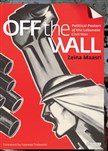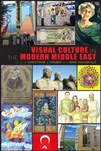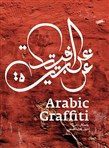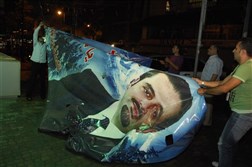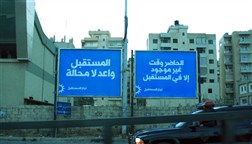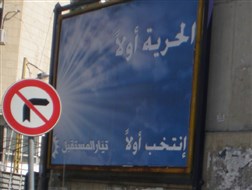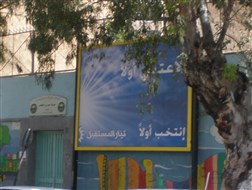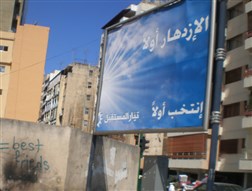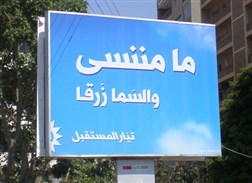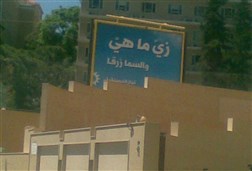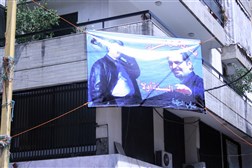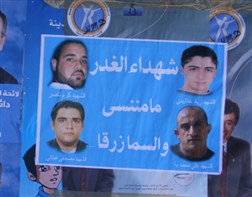The 2009 elections in Lebanon created a platform for the creation of countless political campaigns. The conflict between the different political parties shifted from physical confrontations to a visual battle of billboards. The discourse of each political party was made apparent through these political campaigns as each one of them strived to consolidate their ideology. Tayyar El Mustaqbal (Future Movement) is a telling example since it is a relatively new political party and is now striving to define and propagate its ideals. Tayyar El Mustaqbal is a major representative of the Sunni community in Lebanon.[1] The Sunni community is characterized by a particular relationship of the za'im (leader) to the supporters. According to Michael Johnson, this relationship is grounded on the system of clientelism that clearly defines the role of the leader, the supporters and the mediator.[2] This system is typified by a particular media production initiated by the za'im for the people, and by the people for the za'im, that suggests a new and dynamic form of political propaganda based on clientelism. This new form re-questions the top- down form of propaganda and suggests a specifically Sunni propaganda manifested through the campaigns of Tayyar El Mustaqbal.
A leader, or za'im, has a very particular definition within the Lebanese Sunni discourse. According to Hottigner, the za'im in Lebanon is the "political leader who possesses the support of a locally circumscribed community and who retains this support by fostering or appearing to foster the interests of as many as possible from amongst his clientele"[3] (a prime candidate for this za'ama is the Sunni Prime Minister). This relation between leader and support suggest a very particular power structure that Lebanese politics are based on. Furthermore, this power structure varies between one community and another. Because the Sunnis play a major role in Lebanese politics, a study of the power structure that the Sunni community is based on would be a telling example of Lebanese politics and politicians. This study will concentrate on Beirut, particularly the Tarik El Jdide area as it is the main Sunni and Tayyar Mustaqbal stronghold in the capital city.
In recent Lebanese history, there is a perceivable pattern and similarity between the relationships of the Sunni leader with his community. This relationship bases itself on what Johnson defines as the "clientelist system", defined by the relationship between the client and the patron, whereby the patron provided various services to the client in exchange for electoral support. This system breaks down the Sunni community into three distinct categories: the leader (Patron), the intermediate lieutenant, and the supporters (clientele).[4] The political leader, or za'im, who is a member of parliament or a prime minister, has access to state patronage, which is distributed to his supporters. Moreover, intermediate middlemen or street leaders are recruited by the za'im and are responsible for organizing the clientele of local residents. These appointed middlemen, traditionally referred to as qabadays, are associated with physical strength, blood vengeance and crime. In exchange for organizing and mobilizing the local residents, the qabadays were granted immunity and protection by the za'im. Every qabaday was assigned to a particular neighborhood. Assigning multiple middlemen to the same area was a strategy for the za'im to distance himself from the masses. It also limited the possibility of these qabadays to unite against the za'im and claim more patronage. Effectively, in order to maintain his political status, the za'im provides various benefits (i.e. medical, financial, and educational benefits) to the masses through the mediation of the qabadays who are in turn granted immunity.
Prior to the Lebanese civil war, prominent Sunni za'ims belonged to wealthy families of high social status who had inherited contacts from the Ottoman period such as the Solhs and the Salams[5]. Several Sunni political leaders who adopted the clientelist system during that time were part of these powerful families, and mobilized their communities accordingly. However, with the breakout of the civil war, the National Movement was formed. This movement united all Muslim communities in addition to other political parties. The PLO, which was the driving force of the National Movement, represented the viable Sunni leadership in the country at the time. As a consequence, traditional Sunni za'ims lost much of the power and influence they had on the Sunni community.[6] During that time, Ibrahim Qolailat, a former qabaday and a resident of Tarik El Jdide formed the Murabitun militia, which proved to be a powerful group within the National Movement. This transformation of the power structure within Sunni communities led to the collapse of the previously established clientelist system. Qolailat and other leaders were no longer beholden to their previous patrons. The Lebanese civil war established an alternative movement in Sunni Beirut, independent of the za'im. However, the eventual collapse of the National Movement lead to the fragmentation of the different parties it had previously united. Conflict between the different parties became a confessional one rather than a political one. These confrontations eventually led to the wipe out of the Sunni Murabitun militia. This defeat and the partial destruction of the Lebanese economy were characterized by extreme individualism and the reassertion of clientelism at a later stage.
In October 1989, the Lebanese parliament met in Taef Saudi Arabia to negotiate an accord to end the civil war conflicts in Lebanon[7]. Lebanese multimillionaire Rafik Hariri, who was previously based in Saudi Arabia, fostered this agreement. This led to the instatement of Hariri as prime minister in 1992. In order to reinforce his Sunni za'ama, multimillionaire Rafik Hariri went on to purchase and financially support various institutions and land in Beirut. He founded Solidere, which took over most of Beirut's central district (former downtown). He also purchased the old presidential palace in Qantari and turned it into production studios for his privately owned television station, Future Television. Future newspaper and Radio Orient were also founded and owned by Hariri. Moreover, he provided financial support to the Makased Association, a major Sunni Muslim educational institution established in the early 20th century (previously under the direct control of the Soloh and Salam families). He additionally established the Hariri Foundation that provided medical and educational services.
Hariri's za'ama persisted, as he was prime minister of Lebanon form 1992 to 1998 and again from 2000 until his resignation on the 20th of October 2004. On the 14th of February 2005, Hariri was assassinated in a car bombing. This led to renewed political turmoil, and the position of leadership held by Rafik Hariri was passed on to his son Saad Hariri[8]. As Khalaf claims, patronage has become almost institutionalized into Lebanon's body politic[9]. The period between 2005 and 2008 is characterized by an extreme polarization of the main political coalitions in Lebanon due to the rise of Hizbollah representing the main Shiite community and the newly founded Tayyar Mustaqbal representing the main Sunni community, led by Saad Hariri. This polarization culminated in violent confrontations in May of 2008 and resulted in the storming of Tayar Mustaqbal political offices in Beirut by Hizbullah and Amal supporters on May 7th. However, an agreement was reached concerning the Tariq El Jdideh area resulting in a consensual handover of the offices in order to avoid confrontations and further bloodshed.
The continuous conflicts and political tension between February 2005 and May 2008 witnessed the emergence of intense political propaganda in Tariq El Jdideh, manifested through the massive production of posters and banners in support of Tayyar Mustaqbal and the Sunni community on a larger scale. However, in September 2008, an agreement was reached between P.M. Saad Hariri and Speaker of the Parliament Nabih Berri to remove "all provocative signs and called on the various Lebanese groups to get rid of posters, banners and slogans hoisted across Lebanon"[10] as an attempt to subdue political tension following the May 7 events (fig.1).
The enforcement of this agreement was short-lived as numerous political campaigns started to develop in February 2009. The political campaigning shifted from the level of small-scale posters and banners to large-size billboards and uni-poles in preparation for the upcoming elections. The visual language adopted by these billboards contrasts with traditional political propaganda tools. Contrary to small-scale banners and posters, the production of billboards takes on a more official form that entails greater responsibility on the part of the political party.
In order to better understand this new tool of political propaganda of Tayyar El Mustaqbal in particular, we will analyze the three campaigns produced between March 2009 and June 2009. Our study is based on a semiotic analysis of the billboards and on the encoding/decoding model proposed by Stuart Hall, which is framed in a cultural studies perspective to media discourse[11]. This model enables the study of how messages are discursively encoded and decoded by agents and viewers at both ends of the communication chain according to their respective frameworks of knowledge and subject positions.
MARCH 2009
Campaign 1: Quotes from Arabic literature and popular sayings (fig. 2)
Produced by: Quantum (Saatchi and Saatchi)
This campaign was exclusively printed on billboards in various areas of Lebanon but was absent in Beirut. This typographic quote is set against a blue background (the signature color of Tayyar El Mustaqbal) and is signed by the party's logo and name. The exclusive use of typography and the absence of imagery resemble the visual language of the banner or the yafta. The use of the word mustaqbal in these quotes works as a play on words whereby the party borrows popular quotes and appropriates them within a new discourse, that of Tayyar El Mustaqbal. In using these literary quotes, Tayyar El Mustaqbal assumes intellectual authority over the people it was striving to reach. The use of these quotes is perhaps unsuited to the audience that this campaign aims at targeting. Furthermore, the presence of these billboards in areas that are not particularly in support of Tayyar El Mustaqbal also counters the main aim of this campaign. Thus, two apparent obstacles stand between the encoder and the decoder of the message: the choice of language and the geographical location. This issue is perhaps the reason Tayyar El Mustaqbal changed their choice of advertising agency.
APRIL 2009
Campaign 2: Awwalan series (figs. 3, 4, 5)
Produced by: Impact BBDO
The Awwalan series of billboards is based on a slogan that was made popular on the second commemoration of Rafik Hariri's assassination. The original slogan, Lubnan awwalan (Lebanon first), was used as a base for this campaign. A series of 20 billboards was created with a play on this slogan by replacing the word Lubnan or Lebanon by words such as agriculture, security and economy. All of the 20 variations were coupled with the slogan Intakheb Awwalan or "vote first". This series equates different words that represent various national concerns, but the keyword here is "vote", as it adds a new layer of meaning to all these slogans. The type is set against blue skies with a radiating sun pointing at every one of these slogans (a photographical representation of the logo of Tayyar Mustaqbal). By simply and clearly equating national concerns with the word "vote" this campaign communicates that it is only by voting for Tayyar Mustaqbal that these concerns will be addressed. In comparison with its predecessor, this campaign introduces a new visual element: that is the blue sky instead of a plain blue color.
MAY/JUNE 2009
Campaign 3: Wil Sama Zarka Series (figs. 6, 7)
Produced by: Impact BBDO
On May 7th 2009, Tayyar Mustaqbal organized a political rally to announce the candidates for Beirut and to coincide with the first anniversary of the events of civil unrest in May of the previous year. During that rally, Saad Hariri addressed his audience with a speech from which the following excerpt was taken:
"It is the first anniversary for that wretched day, when insanity thought it could invade Beirut's steadfastness. Here I ask of you to stand for a moment of silence to honor the souls of the martyrs who fell on that day in Beirut. I chose this very place and this very day, to look out for the future, and not the past as some would like us to"[12]
Saad Hariri was giving his speech with a huge blue backdrop of a portrait of his father behind him that read Ma mninsa wil sama zara'a (We will not forget, just like the sky is blue). The Arabic saying "wil sama zara'a" is literally translated to English by "The sky is blue", i.e. it is a fact. This phrase became the main slogan for the campaign that followed the rally and was released the next day all over Lebanon.
In its first phase, three versions were released using almost every single advertising space at hand. These three versions are:
Ma mninsa wil sama zara'a (We will not forget, just like the sky is blue)
Ma byrijao wil sama zara'a (They will not come back, just like the sky is blue)
Ma mnitirkak wil sama zara'a (We will not leave you, just like the sky is blue)
The saying wil sama zara'a also makes a relation to the blue sky used in the previous campaign and that relates to the signature color of Tayyar Mustaqbal. It also suggests a change of tone from the rather neutral one used in previous campaigns. As the elections approached, there was a need to use a more passionate tone that would have the power to mobilize the masses and consequently secure a larger amount of votes. Reminding the residents of Beirut about the confrontations of the previous year, of the martyrs, and the "invasion" was used as fuel for this campaign. As for the visual treatment, it took the same elements of the previous campaign and developed them further. The blue sky became brighter, the slogan became bigger and bolder, with the signature appropriately placed in the bottom left corner. The enhanced visual treatment went along with the "louder" tone.
Ten days prior to the elections, on the 28th of May (fig. 8), the second phase of this campaign was released, replacing the previous variations of the slogan with Zay Ma Hiyye, Wel Sama Zarka or "as it is, and the sky is blue". Rafik Hariri made this slogan popular in previous elections. It uses colloquial language and is a direct call for supporters to vote for a set list of candidates provided by Tayyar El Mustaqbal without making any changes (crossing out or leaving out any of the candidates). It is both a call to the people to vote for the complete list and a promise to the opponent that the complete list shall win the elections.
The analysis of these campaigns outlines an evolution of the tone used by Tayyar El Mustaqbal. As the election date approached, the language used went from sophisticated to colloquial, from a saying to a demand directed at the people, and from a neutral voice to a more zealous voice. The message went from a self-directed one to one that targets and defines an opponent. Although the first campaign appropriated the visual language of a yafta, but did not function as one with its literary language, the last campaign did not look like a yafta, but did function like one as it used language which is closer to that of the people.
With the official campaigning taking place, small-scale posters and banners started reemerging in Tariq El Jdideh. These unofficial posters produced by individuals, groups or organizations functioned in two different ways. Their mere presence in the streets of Beirut evaluated the amount of support that the party had from the people. Their presence also testified to the party supporters' own understanding of the official campaigns which were happening in parallel.
In order to take a look at the visual production that took place in the streets and alleys of Tarik El Jdide, we went down to the area to observe and document the posters and banners. Our first attempt was a failure when we were requested to put down our camera by "security men" from Tayyar El Mustaqbal. We were told that we had to get a permit from the party in order to take pictures.
The next step was to get in contact with the Tayyar Mustaqbal coordinator in Tarik El Jdide, who sat down with us as we tried to explain our topic of research and who passed us on to Mr. Tarek El Dana, who we were told will: "make the appropriate arrangements for anything you need". Few days later we met Mr. Dana who is a modern qabaday in control of a large area in Tarik El Jdide. He is tall, has sleek hair pulled back, and his demands are met with direct approval from his "people". Our request to take photos was met with approval and some confusion; however, Mr. Dana gave us a time and place to come where "one of the young men" will escort us around the area. True to his word, a group of young men were gathered at the meeting place that day and one of them did take us around on his motorcycle. Furthermore, on that very day, Saad Hariri was scheduled to come to Tarik El Jdide for a political rally but cancelled the gathering the night before.
The Free Patriotic Movement website on May 15th (a day after the cancellation) www.tayyar.org included in its news feed that the reason for the cancellation was due to the fighting which happened between Tarek El Dana's "people" and those of Shaker El Birjaoui. These two personalities are different men in charge of different neighborhoods in Tarik El Jdide.
This whole story just narrates the way the clientelist system has been totally reinstated with the newly found parties as a very clear hierarchy is found between leader, officials, intermediate middlemen, and the general public. And in order to get from one point of the scale to the other, a highly bureaucratic process is to be followed.
In order to carry out this comparative analysis, we chose three examples where the unofficial posters and banners used the same slogan as the official campaigns, but re-appropriated it to formulate a new interpretation and understanding of its meaning.
CASE 1: al-Sunna awwalan (Sunnis first) (fig. 9)
In this instance, the slogan used in the second official campaign is maintained. However, instead of using a broad notion such as economy or security, the "residents of the area" who signed the poster chose a more particular notion that is of more importance to them. The poster proclaims Al Sunna Awwalan (Sunnis First), whereby the residents are stating that to them, Sunnis come first (not Lebanon, agriculture, education, economy...). This is due to the fact that the Sunni community felt threatened during the May 7th 2008 events and believed that their community's presence comes first and should be of major importance to their leader. Besides adding a variation to the existing campaign, this poster introduced a more graphic visual element, with the portrait of Rafic and Saad Hariri as representatives of the Sunni community. The neutral language adopted by the original campaign was replaced with a far more passionate voice, which could be a response to the fact that the tone of the original campaign did not live up to the residents' expectations. The official poster was intended to communicate a message of future prosperity and security. In this instance, that same message was decoded by the residents as a call to put the Sunni community's interests first among any other interests, including those called for by the original campaign.
Case 2: Ma mninsa wil sama zara'a (we will not forget and the sky is blue) (fig. 10)
The wil sama zara'a campaign was launched on the first anniversary of the May 2008 events and was accompanied by small unofficial posters in various areas in Beirut. These were posted mainly in the Tarik El Jdide area, in remembrance of victims who fell during the May 2008 confrontations. Four portraits of the young men are placed against the signature blue background and use the same slogan as the third official campaign: we will not forget, and the sky is blue. Tayyar Mustaqbal supporters appropriated that campaign to declare that they would not forget their opponents' attack a year earlier, nor those who died on that day. In this instance, the unofficial poster actually acted as an answer to the official one, since the official slogan left the statement open for interpretation: whom will you not forget? Who are we? The unofficial poster provided one probable answer to the open-ended statement.
Case3: Zay ma Hiyye (as it is) (fig. 11)
The party's request through its final campaign-- for supporters to vote for the set list of candidates during elections-- was met with definite affirmation from the residents that they would comply. Unofficial banners were put up, all using the same quote "zay ma hiyye" and signed by different individuals/organizations/groups. For example, "The Organization of the Ladies of Tarik El Jdide" banner read: "We will put the voting paper as it is in order to conserve the dignity of Beirut." As mentioned, this confirmed supporters' adherence to the party's demand and reinforced the importance of carrying out this act. Moreover, the banner was used as a tool to communicate a message from the people to the leader (contrary to the billboard which was imparting a message from the leader to the people). The name of whoever signs the yafta was considered a guaranteed vote, representing this organization/family/neighborhood.
As seen in the three cases above, the unofficial creation of posters and banners worked in conjunction with the official production of campaigns. First, the unofficial poster put forth the people's own interpretations of the message and reinforced the intended message of the official campaigns. Second, it answered the open-ended nature of the message communicated in the official campaign in other cases. In all three cases, the unofficial campaigns were used as a mediatory tool for the people to communicate various messages of support to their leader who, in turn, communicated his own messages through the official campaigning. In line with the clientelist sytem, when an unofficial poster is put up, signed from a particular person or group, it suggests that the mediator or a party official will see this poster and communicate this message of support to the leader, in exchange for services.
The interplay between official campaigning by the political party and unofficial campaigning by the people suggests a tight relationship between propaganda and the clientelist system. Both function on the basis of a leader providing people with various services in exchange of political support using a mediator. Much like the tough street boss, the unofficial poster embodies the mediator between tha za'im and the people. Furthermore, this re-questions the very notion of political propaganda being a bottom-up power relation (coming from the people). In the case of the Sunni community in Beirut, and with the particular case of political campaigning of Tayyar Mustaqbal in Tarik El Jdide, a completely different model of power structure is suggested, where political propaganda functions within a highly administered power cycle between leader, mediator, and the general public. This power structure is clearly delineated by our struggle in the process to get permission to take photographs. From one perspective, this hierarchy defines the role of each member of society within a bigger framework, and from another, functions on the level of political campaigning. A particular type of official propaganda posters and voice is adopted by the leader, while a completely different voice and type of posters is produced by the masses, each serving their delineated role and for a particular purpose.
Notes
* This essay was originally written for the Signs of Conflict course at the American University of Beirut in the Spring semester of 2009.
[1]Since its establishment, under the French mandate, the Lebanese state included a large number of different sects and confessions. This confessional variety has had a predominant impact on Lebanese politics and policy. One of the major confessions in Lebanon is the Sunni Muslim sect. The Sunni Muslim community has played a major role in Lebanese politics since its establishment. Following the independence of the Lebanese state in 1943, a non-written agreement was reached among Lebanese officials that states, in addition to other clauses, that the Sunni community is to be officially represented by the prime minister (alongside a Christian Maronite president and a Muslim Shiite head of parliament).
[2] Michael L. Johnson, Class & Client in Beirut: the Sunni Muslim community and the Lebanese state, 1840-1985 (London: Ithaca Press, 1986).
[3] Arnold Hottinger, "Zu'ama in Historical Perspective", in Politics in Lebanon, ed. Leonard Binder (New York: Wiley, 1996)
[4] Johnson, Class & Client in Beirut, 3.
[5] Johnson, Class & Client in Beirut, 48.
[6] Johnson, Class & Client in Beirut, 105.
[7] Zeina Maasri, Off The Wall: Political Posters of the Lebanese Civil War. (London: I.B. Tauris, 2009).
[8] Maasri, Off The Wall, 57.
[9] Samir Khalaf, Lebanon's Predicament (New York: Columbia University Press. 1987), 98.
[10] "Suleiman Demands Removal of Provocative Signs," Annahar, Sept. 26, 2008.
[11] Stuart Hall, Dorothy Hobson, Andrew Lowe, and Paul Willis (eds), Culture, Media, Language (London: Routledge Press, 1980), 122.
[12] Al-Akhbar, May 8, 2009.
